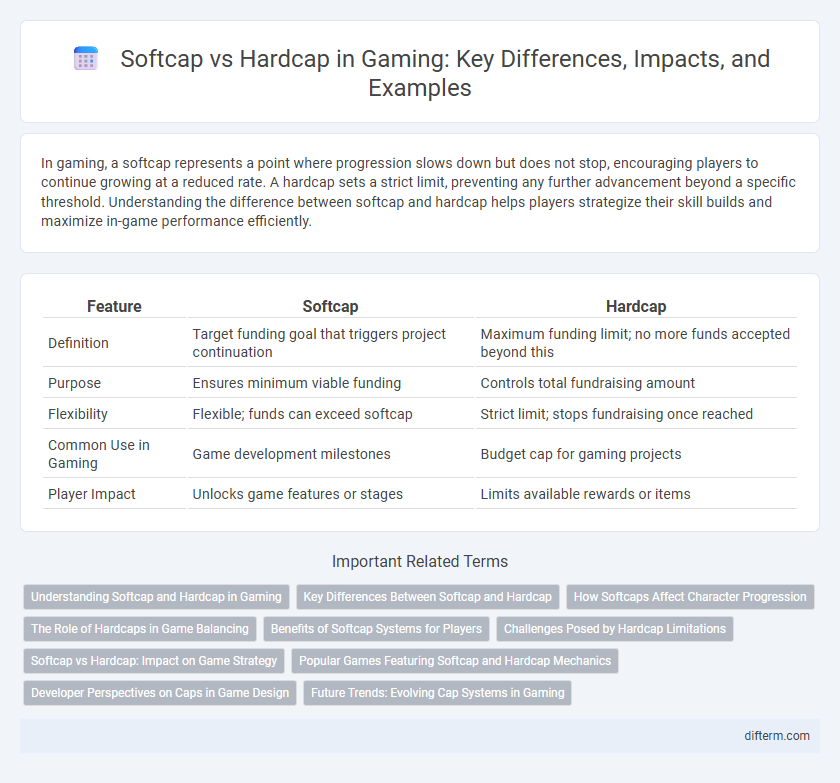In gaming, a softcap represents a point where progression slows down but does not stop, encouraging players to continue growing at a reduced rate. A hardcap sets a strict limit, preventing any further advancement beyond a specific threshold. Understanding the difference between softcap and hardcap helps players strategize their skill builds and maximize in-game performance efficiently.
Table of Comparison
| Feature | Softcap | Hardcap |
|---|---|---|
| Definition | Target funding goal that triggers project continuation | Maximum funding limit; no more funds accepted beyond this |
| Purpose | Ensures minimum viable funding | Controls total fundraising amount |
| Flexibility | Flexible; funds can exceed softcap | Strict limit; stops fundraising once reached |
| Common Use in Gaming | Game development milestones | Budget cap for gaming projects |
| Player Impact | Unlocks game features or stages | Limits available rewards or items |
Understanding Softcap and Hardcap in Gaming
Softcap in gaming refers to a threshold where progress, such as leveling or resource accumulation, begins to slow down but does not stop, encouraging players to strategically manage their efforts. Hardcap represents a fixed upper limit that players cannot exceed, effectively capping stats, levels, or rewards to maintain game balance. Understanding the difference between softcap and hardcap helps gamers optimize their playstyle and set realistic goals within game mechanics.
Key Differences Between Softcap and Hardcap
Softcap represents the minimum funding threshold required for a game's development to proceed, ensuring essential resources are available, while hardcap defines the maximum limit on funds raised, capping total investment to manage scope and expectations. Key differences include funding flexibility, with softcap allowing continuation post-minimum achievement versus hardcap enforcing strict fundraising cessation upon reaching the ceiling. In gaming crowdfunding campaigns, understanding these caps helps developers balance project ambition, resource allocation, and backer confidence.
How Softcaps Affect Character Progression
Softcaps in gaming impose diminishing returns on character stats or experience gains beyond a certain threshold, slowing progression without halting it completely. They encourage players to diversify builds by reducing the efficiency of stacking a single attribute or skill excessively. This design balances gameplay by preventing overpowered characters while still allowing meaningful growth and customization.
The Role of Hardcaps in Game Balancing
Hardcaps in gaming establish definitive limits on player progression or resource accumulation, ensuring fair competition and preventing exploitation. They play a crucial role in game balancing by setting maximum thresholds that maintain challenge and prolong gameplay engagement. Unlike softcaps, which gradually reduce benefits past a certain point, hardcaps impose absolute ceilings that prevent further advancement or gains.
Benefits of Softcap Systems for Players
Softcap systems in gaming offer players increased flexibility by allowing continuous progression and rewards beyond the initial threshold, unlike hardcaps that impose strict limits. This design encourages sustained engagement and reduces frustration by providing incremental rewards without abrupt stops. Players benefit from a more balanced and enjoyable experience, promoting long-term motivation and skill development.
Challenges Posed by Hardcap Limitations
Hardcap limitations in gaming impose strict boundaries on resource accumulation or character progression, often stifling player creativity and strategic diversity. These rigid constraints can lead to repetitive gameplay experiences and reduced player engagement as options become limited once the cap is reached. Developers face challenges balancing difficulty and reward systems to maintain player interest without risking frustration due to these hard limits.
Softcap vs Hardcap: Impact on Game Strategy
Softcap and hardcap systems significantly influence game strategy by determining resource limits and progression pacing. Softcaps allow continued growth with diminishing returns, encouraging players to adapt strategies beyond peak efficiency thresholds, while hardcaps impose absolute limits, forcing players to optimize within fixed boundaries. Understanding these mechanics enables gamers to balance risk and reward, prioritizing skill development or resource allocation to maximize performance under each cap type.
Popular Games Featuring Softcap and Hardcap Mechanics
Popular games like "Dark Souls" and "World of Warcraft" implement softcaps to gradually reduce experience gain rates, encouraging balanced character progression without abrupt limits. Titles such as "Diablo III" and "Fortnite" use hardcaps to set fixed maximum levels or achievements, providing clear endpoints for player goals. These mechanics shape gameplay by controlling advancement pace and enhancing long-term engagement through distinct progression constraints.
Developer Perspectives on Caps in Game Design
Developers view softcaps as flexible thresholds in game mechanics that encourage player progression while maintaining challenge balance, allowing scalable difficulty and prolonged engagement. Hardcaps establish definitive limits on character attributes or resources, ensuring game stability and preventing exploitation but potentially restricting player creativity. Balancing softcap and hardcap implementation is crucial in game design to optimize player satisfaction and system integrity.
Future Trends: Evolving Cap Systems in Gaming
Softcap and hardcap systems in gaming are evolving to create more dynamic player progression experiences, balancing reward pacing with engagement longevity. Future trends indicate the integration of adaptive cap systems utilizing AI to tailor difficulty and rewards based on individual player behavior and skill levels. These innovations aim to sustain motivation and enhance gameplay satisfaction by shifting from rigid progression limits to flexible, personalized advancement models.
Softcap vs Hardcap Infographic

 difterm.com
difterm.com